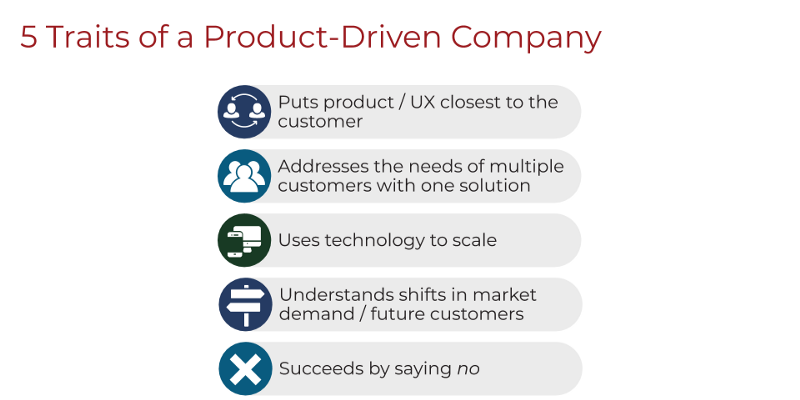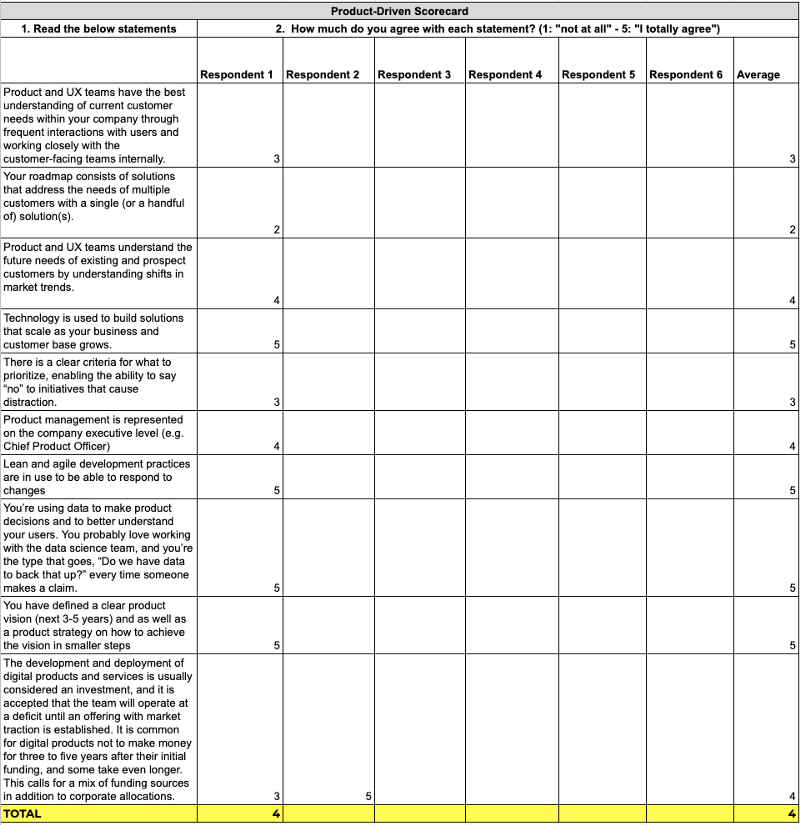Are you a product-driven company? Take the quiz (with a scorecard)

Most CEOs, founders, and product managers claim to be product-driven.
Or at least they strive to be one.
However, when you ask them:
“What does it mean to be product-driven?
“How do you know you are moving in the right direction?”,
They lapse into silence.
Ben Foster and Rajesh Nerlikar state in their book “Build What Matters” that there are two core operating tenets of being a product-driven company:
You address a customer’s need through a solution applicable to the broader market
Product decisions come first, and other decisions follow
In product-driven organizations, all the functions of the company are focused on the product — its design, features, capabilities, and its subsequent design and manufacture. All the other departments act as support for the product, and that includes the finance, human resources, and even IT sections.
The marketing and sales team will be responsible for taking the product and introducing it to the market.
In this setting, products are managed as though they are independent business segments or even standalone businesses.
Persons will be assigned specifically to the product, and the product manager is at the helm, taking on the role of the CEO of that product.
All their efforts and resources will be poured into that product.
Read our range of product management case studies from airfocus users.
Are you product-driven?
Ben Foster and Rajesh Nerlikar describe in their book “Build What Matters” five traits of a product-driven company and also offer a useable scorecard to conduct an assessment:
1. Product-driven companies put product / UX closest to the customer
Product teams are spending time with their customers.
They have the best understanding of the current and future customers within the organization.
Product teams have frequent interactions with users (e.g. user experience labs, feedback surveys, etc.)
2. Product-driven companies address the needs of multiple customers with one solution
A product-driven company addresses the needs of multiple customers with a single solution (or few solutions) that works for all of them.
3. Product-driven companies use technology to scale
Problems are solved with the use of technology and technology scales every part of the business.
4. Product-driven companies understand the shifts in market demand / future customers
Product teams must actively seek out market research focusing on market trends and shifts. They listen to current customers and prospects to understand and predict changes in customer demands, needs, and behavior.
5. Product-driven companies succeed by saying no
As Steve Jobs famously explained, “innovation is saying no to 1,000 things.” Product-driven companies clearly define their market and confidently say no to solving the problems of the noisy customers outside of their target market.

From my experience as a Business Agility & Product Coach at several clients in different industries I have added some additional criteria to the product-driven scorecard:
6. Product management is a C-level concern
The CPO focuses on the why of the product while the CTO on the how.
Product-driven organizations usually have a C-level product management role (e.g. Chief Product Officer).
The Chief Product Officer is a strategic leader, visionary, team supervisor, and an advocate of an organization’s product (or products).
The primary goal of the CPO is to lead and facilitate the creation of products that deliver value to both customers and the business.

7. Lean & agile development practices are in place
Product teams use lean and agile practices when developing the solution.
They work with a clear prioritization in short iterations. Product teams are easily able to respond to changes in customer behavior.
8. Data-driven decision making
You’re using data to make product decisions and to better understand your users.
You probably love working with the data science team, and you’re the type that goes, “Do we have data to back that up?” every time someone makes a claim.
9. Product vision & strategy in action
You have a clear product vision for the next 3–5 years.
You have defined a product strategy on how to achieve the product vision in smaller steps.
The product strategy contains the target segments and the competitive advantage you want to acquire or extend.
10. Your investment model support being product-driven
The development and deployment of digital products and services is usually considered an investment, and it is accepted that the team will operate at a deficit until an offering with market traction is established.
It is common for digital products not to make money for three to five years after their initial funding, and some take even longer.
This calls for a mix of funding sources in addition to corporate allocations.
These 10 traits can be assessed in a product-driven scorecard by different stakeholders. Therefore, each stakeholder has to assess 10 statements on a scale from 1 (disagree) to 5 (totally agree).
The results
Based on the average result you get a total score between 1 and 5:
1–2: “Your company has a long to go to become product-driven.”
3: “Your company is not yet product-driven. The good news is that your company has adopted some traits of a product-driven organization. But there is still a long way to go…”
4: “Not bad. Your company has adopted many product-driven traits.”
5: “Great news! Your company is product-driven! Stay on it!”

You can get the product-driven scorecard here: https://docs.google.com/spreadsheets/d/16hy6A2lk70nlIAdJnt600GI7WNZLhZEW7BLGok6S5UM/edit#gid=309106681
Case studies and success stories
Here are just a few examples of successful product-driven companies.
Apple
Part of Steve Jobs’ genius was the ability to sell the world products they never knew they needed. Rather than relying on marketplace data or following the crowd, Jobs pushed Apple to develop brand-new products that would drive innovation. The results spoke for themselves. Apple rapidly went from being just another tech company to a household name and lifestyle brand.
While other companies scrambled to keep up with Apple’s innovations, customers lined the streets trying to get hold of the newest Apple product. This meant the company could continue focusing on innovation and product-led growth because they didn’t have to worry about falling behind their competitors.
Amazon
Amazon’s product-driven approach was unique because they essentially worked backwards. Product teams would create materials as if preparing for a launch, including a press release, FAQs, mockups, and detailed narratives describing what a customer would do with the product.
This approach allowed Amazon to develop products that directly addressed customer needs. It gave them a clear objective and allowed them to build in a way that offered nothing but value.
Sony
For decades, Sony has led the world in innovation. Their progression since their humble start making rice cookers all the way to the PlayStation 5 has been powered by putting customer needs first, creating products that appeal to a wide audience with great success.
What’s unique about Sony is that they’re not trying to compete with the other big names in consumer tech. Choosing to stay away from crowded spaces like smartphones and computing products, they’ve carved a space in other areas like audio and visual. This has allowed them to continue focusing on products rather than competing with other companies.
Tools and technologies for product-driven companies
Let’s briefly look at the tools and technology that can empower product-driven companies and how airfocus can help.
Product roadmap templates - Roadmaps are crucial for any product-led strategy. Being able to quickly produce a roadmap with one of airfocus’ pre-built templates allows teams to spend less time worrying about what needs to be done and more time actually doing it.
Built-in prioritization - Product-driven strategies aim to add as much value to a product as possible. This means teams must make tough decisions about what goes into the product. Easy prioritization through airfocus’ clear scoring frameworks and Priority Poker makes trimming the fat from your development cycle simple.
Feedback and Insights - Building products with maximum value requires a strong understanding of your market and customer needs. Through airfocus Insights, you can gather feedback from a wide range of channels and organize it all in one place. This helps you identify and address needs much faster than traditional methods.
Portal - Keeping customers in the loop on new developments is a great way to build hype around your product and gain fast feedback about how they view your plans. You can use airfocus Portal to easily update customers by sharing roadmaps, plans, and releases.
About the Author
Sebastian Straube started his career as a consultant focusing on digital transformation and digital strategy. Then he was eager to actually execute the strategies and build real products. Thus, Sebastian became a product manager developing mainly eCommerce applications and innovative mobile apps. Building on that experience, Sebastian wanted to bring his passion for product development to other teams. Now he is a product management & discovery coach at Accenture | SolutionsIQ and helps clients build empowered product teams that develop extraordinary products. His focus lies on product visioning, product strategy, and product discovery.
The original article was written in June 2021 and updated in May 2024.

Sebastian Straube

Read also





Create effective product strategy

Experience the new way of doing product management


